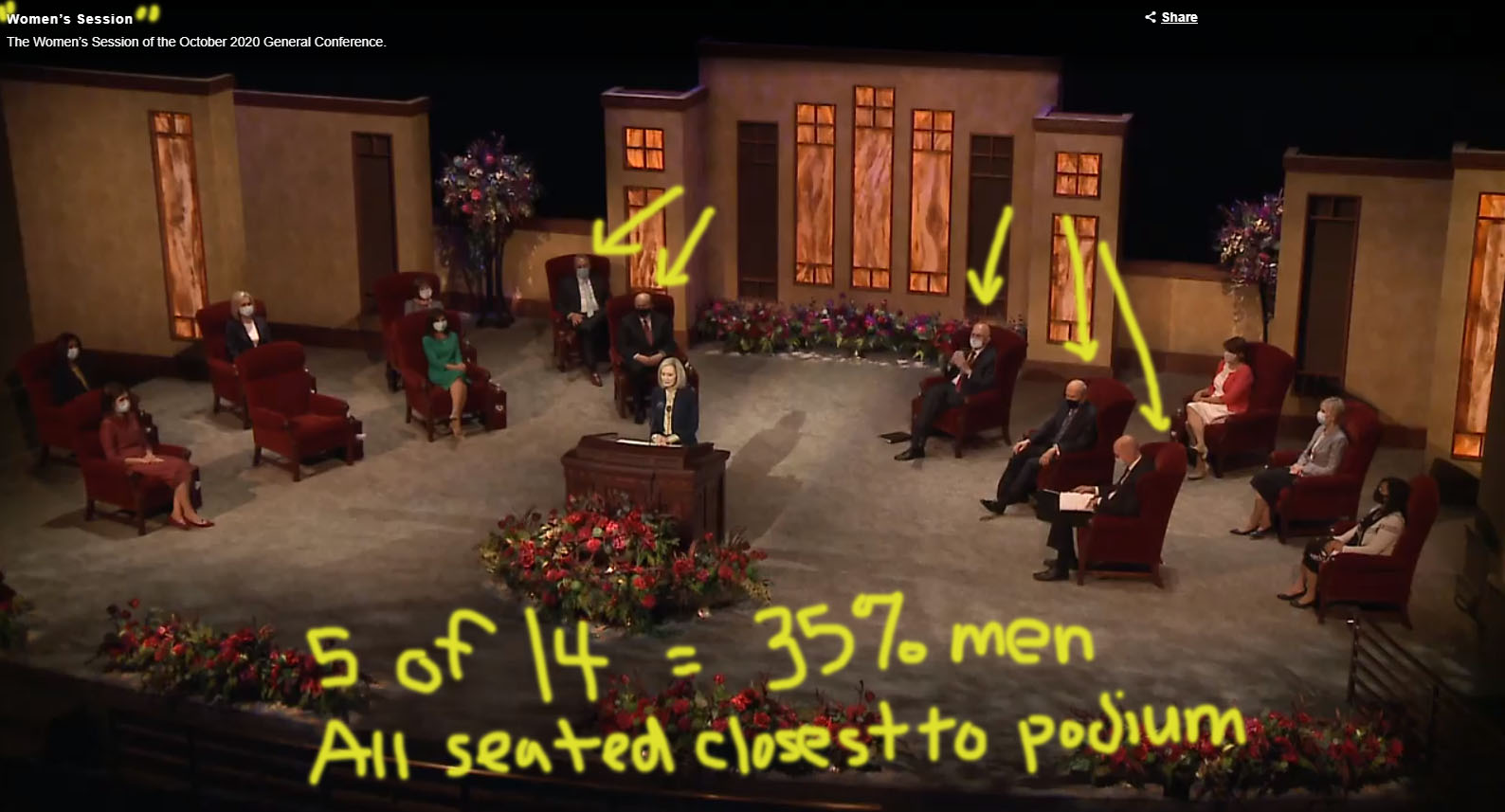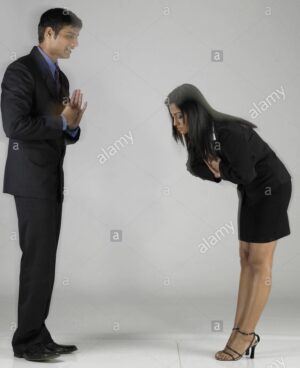LDS General Conference was not a great experience for me this time. Most of the time I’m able to get at least something from conference, and many times it’s been a spiritual feast of sorts. But this time, it wasn’t. I wasn’t able to listen to most of the Saturday session as it was happening because Jared and I were working on putting up his shed. Once it got dark I was able to come in and listen to the women’s session, but I got interrupted just as Sister Eubank began to speak with a scheduling problem for my aunt’s caregivers that meant I had to re-do three months of scheduling all of a sudden. I came back to the session I had paused, and saw this:

…and spent the rest of the evening weeping — not the ugly sobs I’ve emitted of late, but silent tears of grief. I was left questioning my value as a woman and my place in the kingdom. Again. I know not everyone sees it this way, and I am always hesitant to point this out to other women in the church because once you see it, you can’t un-see it. But for me, looking at that setup made me feel that no matter what we say individually in public about valuing women’s voices and honoring women’s authority, we keep acting like we don’t actually believe it, because we still do not recognize women’s authority institutionally.
I’m aware that the men in the photo have said unequivocally that women have genuine priesthood authority. One can point at Elder Oaks’ 2014 talk Keys and Authority of the Priesthood and argue that he doesn’t doubt women’s authority. But when you SAY this:
We are not accustomed to speaking of women having the authority of the priesthood in their Church callings, but what other authority can it be? When a woman—young or old—is set apart to preach the gospel as a full-time missionary, she is given priesthood authority to perform a priesthood function. The same is true when a woman is set apart to function as an officer or teacher in a Church organization under the direction of one who holds the keys of the priesthood. Whoever functions in an office or calling received from one who holds priesthood keys exercises priesthood authority in performing her or his assigned duties.
But you DO this:

…I think I am not being unreasonable when I question if you really mean that you believe in women’s authority.
I’m trying to think good thoughts. I mean, 6 of 9 female leaders spoke at conference in 3 of the 5 sessions. Proportionally that’s an outsized representation of female leadership. There are only nine women who are on the bench, compared to I dink know how many men. We get an outsized voice proportionally speaking. I get it. And women got to pray and conduct at “our” session, so that’s good. The music for the women’s session was a recording of a women’s choir.
But the presence of so many men in women’s meetings makes me doubt myself and my own priesthood power and authority. Don’t men trust us? Do they trust me to lead? Should I trust me?
Having more than one man speak at the women’s session is new
Historically speaking, the inclusion of this number of men at women’s broadcasts is a departure. The first ever LDS women’s conference broadcast was in 1978. Beginning at that first broadcast and into the 2000s, only one man spoke at the Relief Society or women’s broadcasts. Here’s an exhaustive history of the broadcasts:
- 1971-1974 – no record for women’s sessions. There were no female speakers at general conference during these years although there were 6 sessions.
- October 1975, April 1976, October 1976 – no record for women’s meetings, Barbara B Smith, GRSP spoke for the first time at newly added Welfare Session October 1975 (Conference change to 8 sessions in October 1975) (Notably, BBS was the church’s face of ERA opposition.
- April 1977, October 1977, April 1978 – no record for women’s meetings, Barbara B Smith, GRSP spoke at Welfare Session (Conference changed back to 6 sessions of general conference in April 1977.)
- October 1978 – Barbara B Smith, GRSP spoke in welfare session; this is the first women’s broadcast records we have because this was the church’s first ever broadcast using the closed-circuit satellite system — probably a soft roll-out, Sister Ruth H. Funk, formerly general president of the Young Women organization; Sister Elaine Cannon, Young Women general president; Sister Barbara B. Smith, Relief Society general president, and Spencer W. Kimball president of the church spoke (Spencer W. Kimball said, “As one of the few men privileged to be with you in this momentous gathering, I come to you tonight with a message of peace and hope and love, a message of advice and counsel, a message of faith and encouragement and confidence.”)
- October 1979 – Barbara B. Smith spoke at welfare session; at the Women’s session President Spencer W. Kimball; Sister Barbara B. Smith, general president of the Relief Society; Sister Elaine A. Cannon, Young Women general president; and Sister Naomi Shumway, Primary general president spoke. Since President Kimball was hospitalized at the time of the conference, his message was read by his wife, Camilla E. Kimball.
- April 1980 – Shirley W Smith spoke at Welfare session
In the fall of 1980 and 1981, this conference became the general Relief Society meeting. The speakers included one member of the First Presidency and the whole Relief Society presidency. The spring of 1982 brought back the general women’s meeting, which then took place each October until 1992. Then from 1993 until 2013, general Young Women and general Relief Society meetings took place every April and October, respectively. (https://www.ldsliving.com/How-the-General-Conference-Women-s-Meeting-has-Evolved-Over-the-Years/s/89366)
For two years, in October 1980 and 1981, this meeting was designated as the General Relief Society Meeting and a member of the First Presidency of the Church, the Relief Society General President and her counselors spoke. In April 1982, they reverted to the General Women’s Meeting format at which a member of the First Presidency and a member of the presidency of each of the three organizations led by women gave a talk. This pattern continued in October 1982 and then annually every October until 1992.
October 1993 marked another shift in the women’s meetings. For two decades, from October 1993 to October 2013, a General Relief Society Meeting was held in conjunction with the October General Conference and a General Young Women Meeting was held in conjunction with the April General Conference, both the Saturday evening immediately prior to the general sessions of Conference.
While speakers were generally limited to those in a general auxiliary presidency, there were exceptions. On a few occasions, members of the Relief Society General Board (October 1980), a stake Young Women leader (April 1995) and other sisters (October 1993) spoke. For three years during President Janette C. Hales Beckham’s tenure as Young Women General President (1995, 1996, and 1997), three young women were invited to speak during the General Young Women Meeting each year, including Fono Latavai, a young woman from Samoa who bore her testimony in her native language as part of her talk. Since April 2008, video presentations including women and young women around the world have been part of these meetings as well. …
Women did not speak regularly in General Conference – to a mixed audience of both men and women – until October 1975, when Barbara B. Smith, the tenth general president of the Relief Society, was invited to speak during the General Welfare Session. President Smith spoke at every semi-annual General Welfare Session from 1975 through 1982 when the General Welfare Session was discontinued, except two: April 1979 featured an all male line-up, and in April 1980 her counselor, Shirley W. Thomas, spoke instead. In addition, in October 1981, a Relief Society sister named JoAnn Randall and her husband Nyle each spoke briefly about how welfare principles had influenced their family. …
Aside from a few anomalies*, April 1984 marked the first time women spoke in general sessions of General Conference. On Saturday morning, Elaine A. Cannon and Barbara B. Smith were released as Young Women General President and Relief Society General President respectively. Both gave brief talks and testimonies in the Saturday afternoon session. Having only had a day’s notice, the newly called Relief Society General President, Barbara W. Winder, spoke in the Sunday morning session and the newly called Young Women General President, Ardeth G. Kapp, spoke Sunday afternoon.
https://gcsisters.wordpress.com/a-brief-history-of-women-speaking-in-general-conference/
It wasn’t until four years later, April 1988, that a woman spoke in a general session of Conference again. President Dwan J. Young was released as Primary General President on Saturday afternoon and spoke Sunday morning. Her counselor and successor, Michaelene P. Grassli, was the only woman to speak in a general session of October 1988 General Conference. From that time through October 1993, the pattern was that one woman, selected from the general auxiliary presidencies, would speak during General Conference. Occasionally, a recently released president and her newly called successor would both speak.
The General Conference of April 1993 marked the first time a woman of color spoke to the general membership of the Church. Chieko N. Okazaki, First Counselor in the Relief Society General Presidency had also previously addressed the women and young women of the Church in the General Women’s Meeting in 1991.
Since April 1994, two women representing different auxiliaries have spoken in general sessions of each General Conference, usually one on Saturday and the other on Sunday.
However, no woman offered a prayer during a general session of General Conference until April 2013. Jean A. Stevens, the First Counselor in the Primary General Presidency gave the closing prayer for the Saturday morning session and Carole M. Stephens, the First Counselor in the Relief Society Presidency said the opening prayer on Sunday afternoon.
Since then, at least two prayers in general sessions of General Conference – one on Saturday and one on Sunday – have been offered by a member of the Relief Society, Young Women, or Primary General Presidencies.
https://gcsisters.wordpress.com/a-brief-history-of-women-speaking-in-general-conference/
- April 1994 – Oct 2013 – 3 women and member of FP spoke at women’s session; 2 women spoke during general sessions, one on Saturday and one on Sunday; there were women’s sessions in both April and October
- October 2014 – The first presidency announces that the women’s session is part of General Conference. “‘The First Presidency has decided that the General Women’s Meeting will be designated as the General Women’s Session of general conference,” said Jessica Moody, spokeswoman for The Church of Jesus Christ of Latter-day Saints.’ (https://www.deseret.com/2014/10/30/20551649/lds-church-confirms-women-s-meeting-now-part-of-general-conference)
- April 2014 – October 2016 – 3 women and member of FP spoke at women’s session; 2 women spoke during general sessions, one on Saturday and one on Sunday; there was one women’s sessions in October and none in April
- April – October 2017 – 3 women and counselor in FP spoke at women’s session; 1 woman in general session
- April 2018 – 3 women spoke in general session; no women’s session
- October 2018 – 3 men and 3 women speak at Women’s session; then 1 woman spoke at conference
- April 2019 – two women spoke in general session
- October 2019 – 3 men, 3 women at Women’s session; then 2 women spoke at conference as usual
- Three women spoke at the April 2020 conference, plus one young woman.
At this October’s session (2020), each of the three women spoke for 10 minutes each. The two counselors in the first presidency each spoke for 12 minutes, and President Nelson took 16 minutes. This means LDS women spoke for 30 minutes in the so-called “women’s” session — “our” session — while men spoke for 40. More than half of the time during the women’s session was male preaching, by men who had already spoken at least once during the conference.
When did three men start preaching at women’s meetings?
Since the first women’s broadcast in 1978, the president of the church or his representative (when he was unwell) has spoken at the women’s broadcast sessions of conference. This changed when President Monson died in January 2018, and Russell M. Nelson became the new church president. I don’t want to be accused of speaking ill of the Lord’s anointed. But it does bear noticing that 40 years of tradition were changed by the new first presidency.
Why did it change?
Why did so many men start speaking in the women’s session? Some may think that this is an attempt to allow the members of the First Presidency more opportunities to speak during each conference. But this doesn’t hold water. Each member of the First Presidency had already spoken at least onece during the conference and got two chances to speak before the change. Plus, it’s 2020. The internet exists. These men have the email addresses of virtually every active woman in the church and can send us any message they’d like to at any time. The entire First Presidency hasn’t felt the need to address women before — or perhaps ever. Why now?
I honestly don’t know why this change was made. No clear reason has been given publicly for the change. It just … happened. It’s the not knowing that has me worried and concerned. I’m not being unreasonable or unfaithful here. I’m questioning my value and place because of the optics of the women’s session.
I suppose someone could assert that the reason there need to be so many men present is that women can’t preside at a meeting because they don’t have keys — that a priesthood holder must be present for the meeting to be valid. I think this is false. Priesthood holders are not required to be at every women’s meeting or to lend legitimacy to every activity. Why? I submit it’s because we actually do believe these women have authority to act in their offices. I say we believe it, because we act like it. (At least sometimes we act like we believe it.) We have also stated in an authoritative source, the Gospel Topics Essay titled Joseph Smith’s Teachings About Priesthood, Temple, Women that “[w]omen did receive authority to preside in the women’s organization.”
So if men are present not because women lack authority to conduct or preside at women’s meetings, are the men present relative to the perceived importance of the meeting? Is it the visibility? Are these men seeking the spotlight? A larger voice? I don’t want to think this way.
But I do.
I don’t believe that our male leaders doubt the ability of women to lead and conduct meetings. But can they see that continually inserting themselves into our meetings undermines that belief? If women have authority–priesthood authority– to run their own meetings, no male presence is needed. We rarely see men attending presidency meetings or class meetings. Heck, a bishopric is instructed to attend young women classes, and I couldn’t get anyone to show up when I was YWP, because the bishopric was too busy with the boys. But I do see men at every major women’s meeting, at every level. Male leaders attend — and attention is directed to them as presiding — at every major women’s meeting from the (now obsolete) New Beginnings, up to Stake RS leadership meetings, and even on the International/Regional level. There is NEVER a time in the Church of Jesus Christ of Latter-day Saints when women are left to conduct major business alone, without a male overseer.
And I use that word ‘overseer’ intentionally, but not aggressively. To preside means “to occupy the place of authority or control, as in an assembly or meeting; act as president or chairperson. to exercise management or control (usually followed by over): The lawyer presided over the estate.” When a male presides over a female meeting, it is because he is the ultimate authority over what is happening at the meeting. He will have approved the speakers, the music, the theme, and perhaps more. He has the authority to stand and stop the meeting if he chooses. It is his responsibility to ensure that correct(ish) doctrine is taught. He may not be presenting or cooking or setting up, but he is presiding — overseeing the meeting.
We say, but institutionally we do not behave as if we believe, women have authority to oversee their meetings in the LDS church.
One reasonable argument for the presence of men at the women’s session is that it’s a session of General Conference, and priesthood leaders are in charge of conference. All right. Then why did all previous church presidencies limit male speakers at the women’s session to one?
The ubiquitous presence of men at LDS women’s meetings makes me feel as if women’s authority isn’t real somehow. I feel like women are like young women or Aaronic priesthood holders: children being supervised as they learn how to lead or conduct or whatever. But I am not talking about children who need supervision or training in leadership. I am talking about adult women, leading the largest women’s organization on the planet, who have authority from God Himself to act in their offices. Why do these women with priesthood authority need overseeing?
Are men imposing or are women inviting?
I’ve run enough meetings to know that sometimes we women invite men to attend our bigger meetings. I’ve had to examine myself here: what is it that I want when I invite a priesthood leader to a women’s meeting that I am organizing and leading?
There are times I’ve wanted my line leader present because I lacked confidence in my own authority, and I wanted keyholders present to lend legitimacy and authority that I myself doubted. Sometimes I wanted a line leader present to give me some praise — to see the good work I’m doing and to offer me some recognition of the sacrifices I’m making to serve. I wanted to show off. These reasons are about me, not about the meeting or its attendees, and they are self-serving. I am trying to be aware of the times I feel this way and avoid seeking attention or acknowledgement from leaders for my work and service.
But an invitation to an activity is not a command. I think that I may have actually felt more confidence in myself and my ability to lead if a priesthood leader had told me no when invited — not because he didn’t want to attend another meeting and not because he was just so busy with the boys’ activities, but because he had every confidence in my priesthood authority, and he told me so explicitly.
I wish more men were interested in truly sustaining, rather than babysitting, me.
Is it all bad?
I don’t know. I am conflicted with these thoughts, and it’s hard not to see the institutional oppression of women at church once you do see it. Our rhetoric does not match our actions, and I am confused and frustrated and hurt.
For example, it’s worth noting that the actual number of women’s voices at conference has not diminished (except for in 2019, thus far). Five women generally speak during all October conference sessions combined, and three usually speak during April sessions. The Young Women session of conference was eliminated, however, which means that another opportunity to hear women’s voices has been dropped. I’m in favor of fewer church meetings, but I’d definitely like to have a chance to get to know the female leadership of the church in the same way I feel I know the apostles and seventies (term limits on female leaders is a topic for another post).
How can it be fixed?
Well, the obvious fix is for men to get the heck out of women’s meetings. Men, don’t show up — don’t preside, invite women to preside at their own meetings. Turn down invitations to women’s meetings. Discourage women from choosing male speakers as keynotes for stake women’s conferences. Encourage women to run an entire meeting all by themselves without your presence. Believe in women’s real priesthood authority and good sense, and show it by trusting women to operate independently.
There’s a part of me that thinks it shouldn’t be radical to suggest allowing women to run ALL of our own meetings, but I recognize that it is. While it remains a radical suggestion, this church will remain susceptible to real, reasonable criticisms about its institutional disbelief in women’s authority.
There’s another possible solution: invite women to the priesthood session of conference. I mean, I have actual priesthood authority. Why am I not invited to that meeting? It definitely seems that if male leaders actually believed in my priesthood authority, I’d be more likely to be invited to a priesthood meeting than men are to be invited to speak at a women’s meeting. You keep telling me I have actual priesthood authority. Male priesthood leaders are not actual women. I belong in a priesthood session. Men do not belong in a women’s session.
Now if you want to keep a men’s and women’s session, I’m fine with that. Just change the name of the “priesthood” session to the men’s session (and kick the guys out of the women’s meeting, thankyouverymuch). You could eliminate both meetings all together and just use direct means to reach members of each group — a fifth, general session of conference. (I hate this latter idea. I like having meetings segregated by gender myself, and I think gender segregated meetings supports the principles in the Family Proclamation. I crave women’s voices and experiences. I want more chances to hear them.)
In Sum
Some may think that I’m breaking my temple covenants and speaking evil of the Lord’s anointed here. I don’t. I think these are reasonable questions. To me, these questions aren’t faithless — they are the opposite of faithlessness. If I didn’t believe in the real, actual priesthood authority of women, I would not wonder about why so many men are in my meetings.
Someday I’d love to attend an LDS church meeting where men did not have to tell me how much they love and appreciate me because they’d already, undeniably, shown me.


